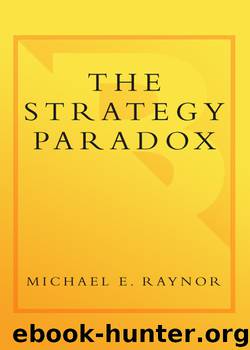The Strategy Paradox by Michael E. Raynor

Author:Michael E. Raynor [Raynor, Michael E.]
Language: eng
Format: epub
ISBN: 9780385521918
Publisher: The Crown Publishing Group
Published: 2007-02-19T23:00:00+00:00
7.2 BCE: THE PARADOX ELUDED
The convergence of technology, media, and telecommunications that so inspired Messier was both a once-in-a-lifetime opportunity and a potentially mortal threat to an Old Economy telco. New technologies and services might whet a nearly insatiable consumer appetite for bandwidth, but with that came the specter of cable and Internet-based voice services, not to mention the genuinely disruptive threat of replacing traditional wireline service with wireless phones.12 Addressing these and many other related questions meant facing up to a strategic challenge of the first order: what businesses should a telecoms company be in? What capabilities did it need to compete, and more pressingly, what resources would it need to control in order to be able to compete in the future? When would the seemingly imminent technological and regulatory changes manifest themselves in ways that required a decisive and committed change of direction?
The challenges associated with these uncertainties were intensified by the seemingly irreducible magnitude of investments required to remain a viable player in almost any sector of the industry. Acquiring or building assets such as a viable wireless business or new video services, or restructuring long-established organizations around new value propositions (e.g., service bundles), are all typically some combination of difficult, time-consuming, and expensive. Yet the competitive environment seemed to demand moving quickly, and so waiting out the storm before choosing a tack did not seem a viable choice.
Many incumbent telecoms firms responded with significant commitments that almost universally failed to live up to expectations. In the United Kingdom, France, and Germany, mainstream telecoms companies ended up paying enormous fees for “third-generation” wireless licenses, believing that the additional bandwidth would prove its worth by enabling advanced services via wireless access to the Internet.13 In the United States, AT&T invested billions in cable systems and wireless networks in an attempt to control what were thought to be the strategically critical thoroughfares on the emerging-but-still-nebulous information superhighway.14 In both cases, the result was the destruction of significant shareholder wealth as these big-dollar commitments failed to generate the anticipated returns.
Enthusiasm for all things converged did not stop at the forty-ninth parallel. Beginning in the mid-1990s, Canada’s largest telecoms company, BCE Inc., found itself grappling with profound questions of corporate scope as it considered investments in wireless telephony, media, e-commerce, computer and network systems integration, and more. The company’s response to these challenges was not only a break with its own past, but a step forward—albeit an inadvertent one—in the evolution of corporate strategy.
BCE was founded as the Bell Telephone Company of Canada, formed by an Act of the Canadian parliament in 1880.15 The company’s first wave of diversification began over a century later, when in 1983 CEO Jean de Grandpré restructured the company, creating “Bell Canada Enterprises” (BCE). BCE was designed initially as a holding company so that management could pursue growth opportunities beyond the limits defined by the original Act. Only Bell Canada, the division responsible for the legacy phone company operations, continued to be bound by those obligations.
Freed of its legislative constraints, the company sought growth, regardless of where it could be found.
Download
This site does not store any files on its server. We only index and link to content provided by other sites. Please contact the content providers to delete copyright contents if any and email us, we'll remove relevant links or contents immediately.
Bad Blood by John Carreyrou(5762)
Principles: Life and Work by Ray Dalio(5315)
Rich Dad Poor Dad by Robert T. Kiyosaki(5140)
Management Strategies for the Cloud Revolution: How Cloud Computing Is Transforming Business and Why You Can't Afford to Be Left Behind by Charles Babcock(4127)
The Confidence Code by Katty Kay(3561)
Thinking in Bets by Annie Duke(3528)
American Kingpin by Nick Bilton(2966)
Playing to Win_ How Strategy Really Works by A.G. Lafley & Roger L. Martin(2919)
Delivering Happiness by Tony Hsieh(2918)
Project Animal Farm: An Accidental Journey into the Secret World of Farming and the Truth About Our Food by Sonia Faruqi(2655)
Brotopia by Emily Chang(2588)
I Live in the Future & Here's How It Works by Nick Bilton(2520)
Mastering Bitcoin: Programming the Open Blockchain by Andreas M. Antonopoulos(2506)
The Content Trap by Bharat Anand(2488)
The Power of Habit by Charles Duhigg(2483)
The Marketing Plan Handbook: Develop Big-Picture Marketing Plans for Pennies on the Dollar by Robert W. Bly(2408)
The Tyranny of Metrics by Jerry Z. Muller(2399)
Building a StoryBrand by Donald Miller(2358)
Applied Empathy by Michael Ventura(2324)
